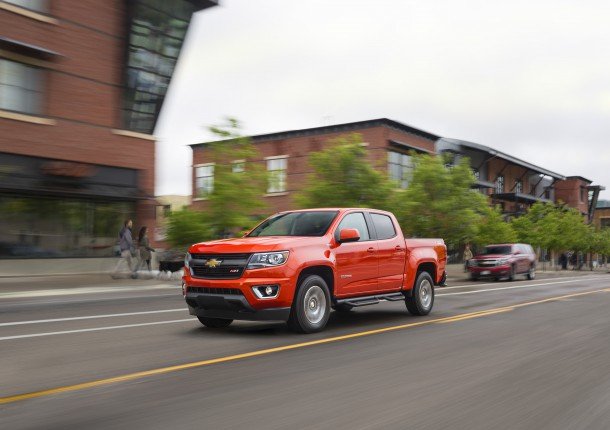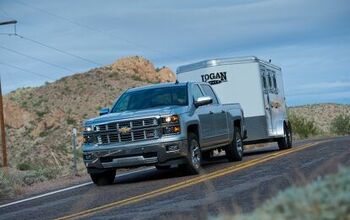Full-Size Pickup Truck Sales Are Suddenly Falling In America
Are the economic successes of Wall Street not being passed down to Main Street? Are concerns over the future post-November direction of the country fostering caution in the minds of consumers? Did certainty regarding forthcoming autumn incentives postpone summer purchases?
And might the benefits of a burgeoning midsize pickup truck class finally be inhibiting demand for full-size pickup trucks?
Whatever the reason, U.S. sales of full-size pickups declined in the summer of 2016 after growing much faster than the overall market coming out of the recession.
In fact, in August 2016, all six nameplates in the category produced fewer sales than they did one year earlier. During the same period, sales of midsize pickup trucks jumped 39 percent.
HISTORY
In 2010, for instance, the overall new vehicle market grew 11 percent, but full-size pickup volume jumped 16 percent. Year-over-year full-size truck growth beat the overall market by more than a point in 2011, by more than nine percentage points in 2013, two points in 2014, and two-tenths of a percentage point in 2015. Even six years on, sales of full-size pickup trucks during the first-half of 2016 grew nearly four times faster than the market as a whole, with few signs of a slowdown.
Until July.
CURRENTLY
It got worse in August. If by “worse” we mean a quartet of Detroit full-size pickups still owning 12 percent of the overall market; if by “worse” we mean the three segment leaders still claiming the top three positions among vehicles overall.
Yes, the slowdown does not represent a full-blown cratering of full-size pickup truck demand. This sky is not falling; the truck market isn’t dying.
Total full-size pickup truck sales fell 6 percent in August, but General Motors spokesperson Jim Cain (no relation) says full-size pickups claimed a particularly high share of the auto industry’s retail market over the summer: 12.5 percent in August; 12.4 percent in July; both better than the 12.3 percent year-to-date tally.
TRENDY
“The Colorado is not cannibalizing Silverado,” Cain told TTAC yesterday, “but it is conquesting F-150, Ranger, and Dakota.”
Cain also says that August incentives for GM’s full-size pickups, as a percentage of the average transaction price, were down 1.3 percentage points, while the same figure increased marginally at Ford and Ram.
According to PickupTrucks.com’s Mark Williams, “Fall typically brings out some good incentive programs as the big players head toward year-end market-share tallies and incoming new models need extra room.” Whether GM’s decreased August incentivization holds remains to be seen. GM had 78 days of Chevrolet Silverado supply heading into September, well below the Ford F-Series’ 95-day supply of Ford F-Series and Ram’s 102-day-supply of Ram pickups.
Midsize TruckAugust2016August2015%Change8 mos.20168 mos.2015%ChangeToyota Tacoma15,37316,230-5.3%126,988122,0644.0%Colorado/Canyon12,6059,53732.2%93,92175,99223.6%Chevrolet Colorado9,2427,11429.9%69,66455,89824.6%Nissan Frontier9,5373,645162%61,79242,64444.9%GMC Canyon3,3632,42338.8%24,25720,09420.7%Honda Ridgeline3,437485,825%9,4295131,738%—— —————Total40,952 29,416 39.2%292,130 241,213 21.1%Nissan should finally report meaningful Titan numbers in the final third of 2016 as the regular-duty model joins the niche-market XD. Toyota has plans, via increased Tacoma production in Mexico and greater full-size emphasis in Texas, for the Tundra to rebound.
Whether full-size pickup trucks can recover from a summer slowdown or continue to show signs of peaking, total pickup truck sales are rising. The losses recorded by the F-Series, Silverado, Ram, Sierra, Tundra, and Titan — all six of them — were counteracted by the much smaller midsize market in August. The Tacoma, Colorado, Frontier, Ridgeline, and Canyon increased their share of the overall pickup truck market from 12.9 percent in August 2015 to 17.9 percent in August 2016.
GM’s data may show little midsize cannibalization of full-size pickup truck sales. But one small corner of the pickup truck market is increasingly not so small after all.
[Images: Ford, General Motors]
Timothy Cain is the founder of GoodCarBadCar.net, which obsesses over the free and frequent publication of U.S. and Canadian auto sales figures. Follow on Twitter @goodcarbadcar and on Facebook.
More by Timothy Cain
Latest Car Reviews
Read moreLatest Product Reviews
Read moreRecent Comments
- Lou_BC Was he at GM for 47 years or an engineer for 47 years?
- Ajla The VW vote that was held today heavily favored unionization (75/25). That's a very large victory for the UAW considering such a vote has failed two other times this decade at that plant.
- The Oracle Just advertise ICE vehicles by range instead of MPG and let the market decide.
- Lou_BC Collective bargaining provides workers with the ability to counter a rather one-sided relationship. Let them exercise their democratic right to vote. I found it interesting that Conservative leaders were against unionization. The fear there stems from unions preferring left leaning political parties. Wouldn't a "populist" party favour unionization?
- Jrhurren I enjoyed this



































Comments
Join the conversation
I prefer to buy a vehicle and keep it for at least 10 years. I put less miles on my vehicles than I did 10 or 20 years ago. I realize I am not the norm but being able to retire without debt and enough savings to live in a comfortable manner are more important than a depreciating piece of metal. The value of a vehicle goes down rapidly during the first 3 to 5 years of ownership and if the vehicle has been well maintained and is not a lemon there remains many years of low cost ownership. There have been books and articles written about how to drive a reliable and safe vehicle for many years past what is considered its useful life with proper maintenance and diving a vehicle in a much gentler manner. Many people who have good jobs spend all their money on cars, clothes, housing, and recreation and never have any savings. Many buy more vehicle and house than they can afford. Nothing wrong with buying a new vehicle but do most people need a new one every couple of years? There are always some who use their vehicles in their business and put above average miles on their vehicles and maybe they do need a new vehicle every couple of years, but most people it is a waste of money that could be spent for more important things or saved for their retirement. The best way to save is if your employer has a matching retirement plan where you can contribute earnings that are tax deferred which means the contributions are not taxed until you withdraw them which for most people should be when they are retired and are paying less tax.
Now that I don't absolutely have to have a full size pickup for work, I traded it for a used BMW X5 sport. Those huge things are just not fun to drive and I hate to think what happens when they need to make an emergency stop at high speed.